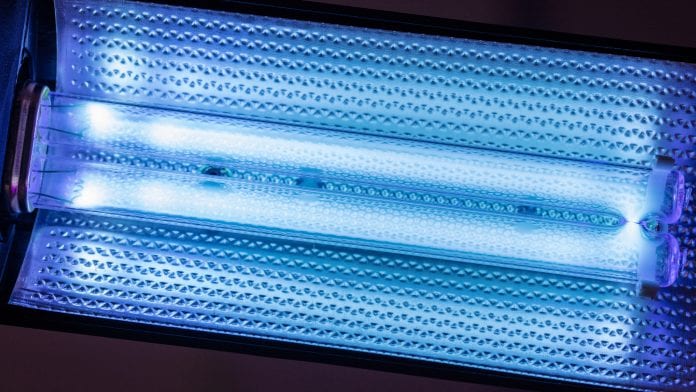
Ultraviolet radiation may be a key component in preventing the spread of COVID-19.
The tactical application of ultraviolet (UV) radiation to disinfect surfaces, objects, water and air has become increasingly prevalent in healthcare settings in recent years, as radiation delivery systems have become safer, more effective and easier to integrate into clinical environments.
Broadly speaking, the effects of UV rays on arresting the spread of infection have been widely known for some time; in the UK, a paper published in the Nature journal in 1877 documented the impact of sunlight on preventing the growth of microorganisms. More than a century later, with the prevention and control of infection at the forefront of healthcare policy, the focus is on the use of technology to deploy UV disinfection in a manner which is both comprehensive and safe for patients and clinical staff.
The benefits of airborne disinfection
One of the most significant advantages of deploying UV radiation in disinfection protocols is that it is non-toxic. Chemical disinfection can rely on substances which may be harmful if consumed, or even corrosive to unprotected skin – and human-led chemical disinfection and cleaning processes carry the inherent risk of contaminating surfaces and, where relevant, food preparation utensils. Excessive doses of UV light can still be harmful, but the UV technologies implemented in healthcare environments are specifically designed to minimise the risk of overexposure for staff and patients.
UV light has been shown to destroy or neutralise a wide array of pathogens, bacteria, spores and fungi: in order to destroy the same range of harmful organisms through chemical means, either multiple substances must be used in order to address all potential threats, or a single high strength cleaning chemical must be deployed, with the attendant risks posed by residue and fumes. Manual chemical cleaning carries the additional potential risk of leaving surfaces damp and internal spaces humid, an atmosphere which fosters the growth of fungi and moulds. Meanwhile, the use of radiation to kill pathogens eliminates the possibility of immunity: disease pathogens which have become immune to antibacterial or antiviral treatment pose a significant challenge in the spread of healthcare-acquired infections (HAIs).
In logistical terms, healthcare operators in settings where UV disinfection technology has been implemented have spoken positively about the ease of installation and use: once implemented, there is rarely any need to move or significantly adjust UV devices, many of which can be operated remotely. The cost of purchasing and installing the technology has dropped markedly in recent years: another boon to often overstretched healthcare services.
UV technology in operating rooms
A 2019 study published in the American Journal of Infection Control found that UV disinfection technology eliminated up to 97.7% of pathogens present in operating rooms. The study, titled ‘Assessment of focused multivector ultraviolet disinfection with shadowless delivery, using five-point multisided sampling of patient care equipment without manual-chemical disinfection’, examined the effects of a focused multivactor UV device on more than 3,000 distinct microbiological samples taken from 100 surgical cases in operating rooms at three New York hospitals.
Donna Armellino, RN, DNP, vice president of infection prevention at Northwell Health and lead author of the study, commented: “Ultraviolet light technology will not replace manual cleaning and disinfection with chemicals, but it has a place in healthcare settings. This technology can optimise environmental cleanliness, resulting in decreased pathogens that could potentially cause infection.”
UVC and coronaviruses
Researchers at Columbia University Irving Medical Center in New York have found that far-UVC light, a lower wavelength form of radiation than that which is typically deployed in disinfection practices, eliminated 99% of seasonal coronaviruses while posing no risk of harm to humans. While conventional UVC radiation, with a wavelength of 254nm, is predominantly used in unoccupied spaces to minimise the hazard to health, far-UVC – which has a wavelength of 207nm to 222nm – has a significantly lower range in biological materials, meaning it is unable to penetrate the living cells in human skin or eyes in the way that standard UVC can. This in turn, the study indicates, means that far-UVC radiation could feasibly be implemented for continuous disinfection purposes in populous, occupied public spaces, such as plains, trains, shops and shopping centres, and entertainment venues.
David Brenner PhD, Higgins Professor of Radiation Biophysics at Columbia University Vagelos College of Physicians and Surgeons, Director of the Center for Radiological Research at Columbia University Irving Medical Center, and lead author of the study, said: “Based on our results, continuous airborne disinfection with far-UVC light at the current regulatory limit could greatly reduce the level of airborne virus in indoor environments occupied by people.
“Far-UVC light doesn’t really discriminate between coronavirus types, so we expected that it would kill SARS-CoV-2 in just the same way: since SARS-CoV-2 is largely spread via droplets and aerosols that are coughed and sneezed into the air, it’s important to have a tool that can safely inactivate the virus while it’s in the air, particularly while people are around. Because it’s safe to use in occupied spaces like hospitals, buses, planes, trains, train stations, schools, restaurants, offices, theatres, gyms, and anywhere that people gather indoors, far-UVC light could be used in combination with other measures, like wearing face masks and washing hands, to limit the transmission of SARS-CoV-2 and other viruses.”
This article is from issue 14 of Health Europa. Click here to get your free subscription today.










